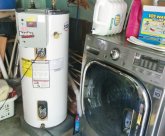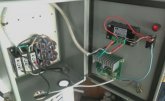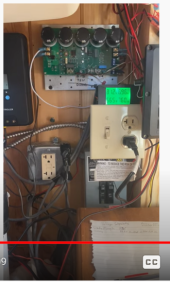efficientPV
Solar Addict
- Joined
- Sep 24, 2019
- Messages
- 1,367



This is in my continuing attempts to live off grid with only a very minimal battery.
my case, a car battery. I purchased this LG washer because it had a variable frequency
motor drive which greatly reduces surge currents and overall consumption of power. I am
able to feed panel DC array voltage directly into a modified MSW inverter. The washer
doesn't care and probably prefers square waves as it only rectifies the AC.
The washer is located in the garage away from the house hot water. I got this tank from
a neighbor. It doesn't leak yet and was replaced because the cold water dip tube that sends
water to the bottom of the tank broke off. This fed cold water to the top of the tank instantly
cooling the hot water. I feed cold tap water into what was the drain valve. Tank is a little
bigger than I would like, but it was free.
The box at the top of the tank feeds excess panel power at power point into the tanks two 4500W
heaters which are in parallel for a combined resistance of 6.5 ohms. A good match for the 60V
array. This allows me to dump about 500W max. That is enough to get the water warm for better
washing.
Everything at the house works on a priority basis. Battery charging is primary, next comes refrigeration,
hot water tanks, dishwasher and last is clothes washer heater.
This is a 2,000W inverter which is way oversized I found in the attic. 60V comes from the house array and
these two Anderson Power Pole connectors select if the garage 60V array is placed in series or parallel.
I bought a QS-60 three phase motor reversing switch to do this. With center off this should have been easy.
In China they decided to save a small amount of plastic on the cam. This actually makes adjacent contats
to momentarily short as they are switches to off. Don't ever buy this switch for any reason.
I've been washing clothes for a week and it works great. Minor clouds don't make it shut down. If it does,
the washer remembers where it was last and you just have to press start. I'm generally out there working
anyway. Somehow I've been made laundry boy.






